I live in an old house and have a wood-burning brick fireplace with no facing or mantle. I recently had a chimney sweep and inspection. The inspector recommended that I install a fireplace facing. I thought that facings were purely aesthetic. But the inspector did not clearly explain why it was necessary, nor could I find a clear answer on the web.
Why should I install a facing, and are there any kinds of materials that are better than others?

Best Answer
A modern, properly installed fireplace should not require a mantle to catch smoke; they are purely decorative. I believe Nathan was referring to the glass doors and metal screen that an indoor fireplace does require to be safe. Also that the inspector may have been referring to the surround (protects the walls around the fireplace and is often topped by a decorative mantel); the masonry directly adjacent the fireplace, on the walls and including a section of the floor.
The white mantle is decorative. The exposed hearth and the tile surround are functional.
Code -rumford.com (note, masonry fireplace; for steel-box construction consult the manufacturer)
Under my interpretation of #4, the mantle pictured is to close to the edge of the fireplace (~8") to stick out so far (~4"). It isn't the best picture to show a safe fireplace. Merely, it does a good job showing a useless mantle. It lacks doors and a screen but at least they attempted to keep combustibles (drywall) one foot from the opening in every direction.